Bali is becoming a hotspot for digital nomads and backpackers alike as a place to live, work and explore from. With warm weather, stunning sunrises, low cost of living and friendly people, it’s easy to see why it would be the chosen place to live. Having spent two months living in Bali, we could definitely see ourselves living here for longer in the future, especially since we had only begun to scratch the surface of this incredible island.
There are many things we wish we knew before we arrived in Bali, such as the best way to get around, where to visit, the best place to stay, etc. We want to share with you all you need to know for living in Bali, what the best places to visit are for your one month in Bali and all of the extra tips we learnt throughout our time here,
This is your ultimate guide to living in Bali, including what to pack, where to stay the cost of living and so much more.
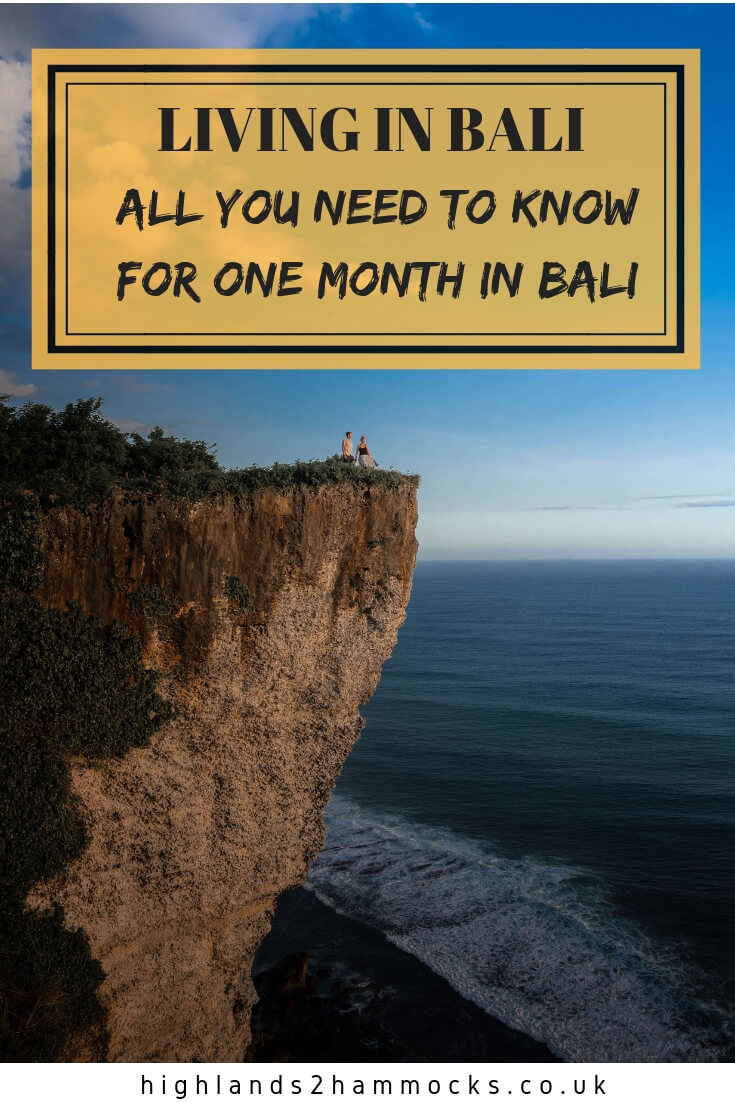
Also Read – The Ultimate Bali Itinerary – Seven Days in Bali Paradise
Moving to Bali – All You Need to Know for One Month in Bali
Before You Leave for Bali
Before you set off on your way to Bali, there are a number of things you will need to get organised to ensure a smooth and enjoyable journey. These include what to pack, where to stay and what is the best insurance for your trip to Bali. All of this is discussed in detail below.
How to Get an Indonesian Visa
As for the Indonesian visa itself, getting a visa for Bali is relatively straightforward if you come from one of the listed Visa on Arrival countries. If your country is on this list, all you have to do is turn up at the airport with a valid passport and you will be granted 30 days in the country. This costs around £28.
If you wish to stay longer than 30 days, you will need to buy a Visa on Arrival Extension. You will then need to extend your visa a further 30 days either by yourself or by paying a visa agent to do so for you.
You can read our full guide to extending your Indonesian visa right here.
What is the Best Travel Insurance For Bali
We know travel insurance is the least enjoyable thing to purchase and look at when you’re planning a trip, however, you wouldn’t want to be without it in the event that something happened. Accidents can happen anywhere and the extortionate medical bills will ruin your trip if you are not covered.
To ensure you have a stress-free trip with no worries about potential medical bills, make sure you cover yourself when you travel. We can recommend using SafetyWing, a backpacker-friendly and cheap insurance company that provides good coverage and support. It is also nomad-friendly, unlike most other insurance companies, meaning you do not need to worry about being out of your home country for too long.
Get a quote for your travel insurance right here and get covered!
What to Pack for Your Trip to Bali
Given the climate of Bali in general, packing for this trip is relatively straight forward. In the southern lowlands of Bali it is hot and humid most of the time, however if you venture into the northern highlands the temperature will drop with altitude.
When it comes to the weather, Bali is a tropical country meaning it has two seasons: wet season and dry season. During your visit to Bali, it will most likely rain, and if you happen to visit during the wet season, it will rain a lot. Make sure you pack a waterproof (men’s / women’s) or a poncho for your days out adventuring to avoid getting too drenched.
As a general rule for packing for Bali, it is best to think “layers”. Pack a few light layers of clothing, including a jumper and a waterproof, and wear as many layers as you want according to the weather.
Given the beautiful sights and scenery that you are no doubt going to see around Bali, we highly recommend packing a good camera for your trip. If you want to read more about the cameras we use and why we love them, check out the link below.
You can read what else we keep in our camera bag over here.
Our Photography Equipment
Main Photography Camera – Sony A7v Mirrorless Camera and Sony A7iii Mirrorless Camera
Microphone – Shure VP83 Condenser Shotgun Microphone
Main Lens – Tamron 17-28mm f/2.8
Zoom Lens – Tamron 70-180mm f/2.8
Camera Tripod – ZOMEI Z669C Camera Tripod
Gorilla Pod – JOBY JB01507-BWW GorillaPod
Action Camera – GoPro Hero 11 and Insta 360 One RS
Drone Camera – DJI Mavic Pro 3
Camera Bag – Wandrd PRVKE 41L and The Nest by Tropicfeel
Phone Tripod – Manfrotto MKPIXICLAMP-BK, Mini Tripod with Universal Smartphone Clamp
Sturdy Phone Tripod & Selfie Stick – ATUMTEK 61″ Selfie Stick Tripod, Sturdy Phone Tripod Stand with Wireless Remote
Hard Drives – LaCie Rugged Mini, 5TB, 2.5″, Portable External Hard Drive
SSD – SanDisk Extreme Pro 1TB Portable NVMe SSD
Travel Adapter –Worldwide Travel Adapter Universal Travel Plug with 4 USB Ports+Universal AC Socket
Don’t forget to subscribe and follow our journey on Youtube here.
Also Read – The Ultimate Nusa Penida Itinerary – Three Days in Nusa Penida

Where to Live in Bali
So you’ve decided you want to move to Bali and now it’s time to decide where in Bali you want to stay. Ideally, you want to choose a place which makes the further reaches of the Bali landscape, such as sunrise points over Mt Agung or the crashing waterfalls in Northern Bali, easily accessible.
It is common to find that expats or people living in Bali choose to live in either Ubud or Canggu. This is mainly due to how backpacker friendly and liveable both of these areas are. They are both full of delicious cafes and restaurants, as well as rocking bars, clubs and other social scenes. The main decision you have to make when choosing between the two is what area are you looking for, beachside or jungle?
Canggu is a very digital nomad friendly area in Bali, full of co-working spaces and cafes. It is also easily accessible to many popular areas in Bali, given its central, southern location. This makes it the perfect base camp for exploring the east and western sides of Bali, as well as the islands surrounding Bali.
Ubud is also very digital nomad friendly and is more jungle than seaside. This area gives you easier access to exploring the north of Bali, sitting right in the heart of the island. This is a popular hop-off point for people exploring the rice fields, waterfalls and mountains around the centre and north of Bali.
What Type Accommodation is Best in Bali
Once you have decided where to stay on the island, it’s time to look into the accommodation you want to live in. This all depends on your needs, whether it be a simple bed and pillow for the night, or whether you need fast wifi, a place to relax and a working space.
Luxury Accommodation
If you are looking for an upmarket villa with a pool and fast wifi, you can expect to pay at least £500 per month (8million IDR) for this in Canggu. There are Facebook groups with villa listings, however you will need to pay your full stay up front and most likely in cash.
Budget Accommodation
If you are looking for cheaper options, look into staying in a homestay or a guesthouse. If you are going to be staying in one place, it is cheaper to book longterm, such as a full month in advance. The longer you book to stay, the cheaper your accommodation will be per night. Look for somewhere that can provide you with good wifi and air conditioning. A fan will not do the job of keeping you cool long term.
One place in particular that we can highly recommend is at Ok Bali Homestay. This is a great homestay in Canggu just up from the local Berawa district, complete with a kitchen, filtered water dispenser and en suite double bedrooms with air-conditioning. This area of Canggu is much more affordable than accommodation on Batu Belong, due to how much quieter it is.
You can browse all of the best budget accommodation right here.
When booking accommodation, it is important to ensure that they include filtered water for you to use. This will save you a lot of money on buying water and will also reduce your plastic consumption.
If the accommodation you choose doesn’t have filtered water, we can recommend buying a Water to Go filter water bottle. These bottles filter out bacteria and viruses, saving your body from dirty water, and the planet from single use plastic.
Also Read – The Definitive Guide to the Gili Islands, Bali – Gili Trawangan, Meno and Air

Check the prices for some of the great things to do in Bali
Getting Around Bali
Despite being a solitude island, Bali is a huge place to get around. There are very little public transportation options and a lot of the best sights that you will want to see are remote and difficult to get to. This leaves you with two options for getting around the island: taxi or self-drive.
Renting Self-Drive Transport in Bali
As for renting your own form of transport, you have two options; renting a scooter or renting a car. In order to get around the island, you will need an international driver’s license. If you do not have one of these you can get a tourist driving license at the police station in Denpasar, which is valid for one month.
If you choose not to get a license, be prepared for police stoppings and fines. You will most likely be fined on the spot for a lack of license, ranging from 50k rupiah to 500k rupiah. A tip for getting stopped is to make sure you separate your money and only keep 50k rupiah on you for a fine. If you pretend to not have more cash, this will probably be enough to get them off your back.
Scooter Rental in Bali
Renting a scooter in Bali is by far the easiest and cheapest way to get around. A scooter will get you around in half the journey time of a car, mainly due to a large amount of traffic on the roads. If you want to get around the island fast, learn from the locals and don’t be afraid to ride a few pavements.
Most homestays, hotels and guesthouses offer scooter rental alongside the cost of your accommodation. Renting a scooter along with your accommodation for a long period of time will work out cheaper than if you are renting for a day or two at a time.
Scooter rental can cost around £2-4 (50-80k IDR) per day, depending on where you go, how long you rent for and how good at bartering you are. Make sure that your rental comes with a helmet and if there are more than one of you, you can ask for an extra helmet for no extra charge.
Car Rental in Bali
The traffic in Bali is crazy and the roads are not built for the amount of traffic that files down the roads everyday. We wouldn’t recommend renting a car to drive in Bali as the chances are, you will be returning it with damage and you will be charged for it. However, that being said cars can be more appropriate for families and large groups to get around with.
If you do decide to rent a car, you can do so for around £15 (300k IDR) per day. Once again this daily rental price will decrease for longer periods of rentals. Majority of the time, insurance is not included when renting a car. This also happens to be the more expensive side of rentals, given how chaotic the roads can be in Bali.
Some of the best places to rent a car from are listed below.
Bali Easy Car Rental
Phone: +62 361 3636 222
Email: [email protected]
Site: www.balieasycarrental.com
Bima Sakti Rent Car
Phone: +62 361 7906 187, +62 81 933 017 722
Email: [email protected]
Site: www.balimobil.com
Where to Get Petrol in Bali
When it comes to petrol, there are plenty of small stalls on the island selling glass or plastic bottles of petrol. Look out for colourful fluid on the shelves at the side of the road, as these are cheaper and easier than stopping at a petrol station. It also means that you can support the local community, by giving the money to a family, rather than a large business.
These are only suitable for scooter and bikes. If you are driving a car, you will need to find a petrol station to top up at.
Depending on where you stop, petrol will cost you around £0.30-0.50 (60-100K IDR) per litre.
How to Get Around Bali
With so much to see and do around Bali, it begs the question of how you should plan to get between all of these activities. When in Bali, you really have two options to get around: self-drive scooter or hiring a taxi driver.
Renting a Scooter in Bali
By far the cheaper and better option to get around the island, renting a scooter in Bali is the easiest way to see as much of this island as you can. Renting a scooter can cost as little as £3/day, with the cheaper rates being offered for long term rentals.
You can rent a scooter from your hotel or homestay itself, or if you are staying in a populated area such as Uluwatu, Canggu or Ubud, you can rent a scooter from a number of shops nearby.
Go Jek and Grab
When you arrive in Bali, one of the first things we would recommend doing is downloading the apps Go Jek and Grab. Both of these apps work similar to Uber in the UK, you can order a taxi on them and you can also order food. If you are not confident in driving a scooter we would definitely recommend this option.
Hiring a Driver in Bali
An easier and much more relaxing way of exploring around Bali is to hire a personal driver to chauffeur you between sights for the day. You can either book a tour online with a detailed itinerary and a set price for the sights you want to see, hire a driver from around the streets of Ubud and barter a price, or book a driver for a day from an online taxi app, like GoJek or Grab.
The cheapest of the above options is definitely with the online taxi apps, who have a set price and do not overcharge for these services. If you want to enjoy a slightly more upmarket experience, booking a a day tour experience will give you a bit more for your money.
You can view the best tours available for around Ubud right here.
Also Read – Visa Extension Bali – Everything You Need to Know about Your Visa Extension Indonesia
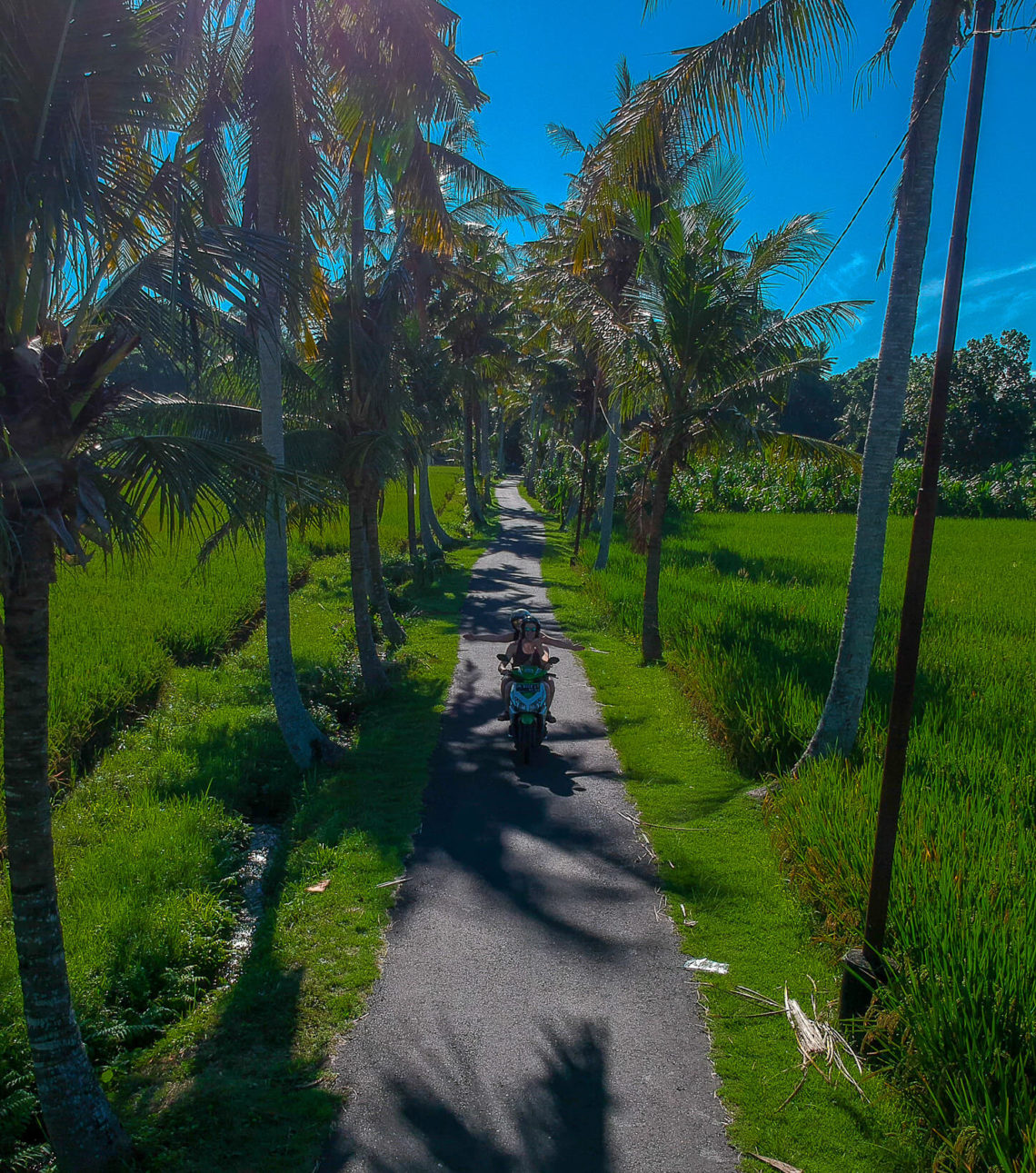
Cost of Living in Bali, Indonesia
Another one of Bali’s best surprises is the incredibly affordable cost of living. When we were in Bali, we budgeted £25-30 (5o0k IDR) per day between the two of us. This budget includes accommodation, scooter rental, food and drink and activities. We found this budget pretty easy to stick to, with it usually balancing out between rest days and highly active days.
This budget would also be a lot less if you choose to stick to one spot for your entire trip and see the island by day trips. We did not do this and instead paid more expensive daily costs for accommodation, scooter rental and food.
Here is a rough breakdown of what you can expect to spend on each different part of your trip, as well as some tips on how to do it cheaper.
Accommodation
As discussed earlier, the price of your accommodation depends on what level of luxury you are wanting to experience living in Bali.
If you choose to go for high-end luxury, you can do so for roughly £500 (8million IDR) per month. This will get you a large apartment with a swimming pool, kitchen and sometimes a cleaner included. It will also include filtered water, fast wifi and AC.
If you choose to stay simple yet comfortable, you can pay as little as £200 (3.5million IDR) per month. This will get you a cosy homestay with a kitchen, filtered water, fast wifi, an ensuite and AC.
Browse the full list of Bali homestays and apartments for a better idea of prices right here.
Obviously this price is per room, so if you are sharing a room the costs will halve. If you are solo, you will possibly be better booking into a hostel dorm, which will work out around £100 (2.million IDR) per month.
Browse the full selection of Bali hostels to get a better idea of price and availability here.
Scooter Rental
The longer you decide to rent a scooter for, the cheaper the daily rates will be. Since you are going to need transport, we recommend that you rent a scooter for the entire length of your stay as soon as you arrive. This can be done from independent rental companies or straight from your accommodation.
The cost of renting a scooter can very from £60-100 (1.2-2.4million IDR) per month.
Again this price is for one scooter, so if you are travelling as a pair you can halve the price for per person.
Food Costs
The most popular way of eating in Bali is to dine out, whether it is at an expensive restaurant or a cheap warung. The reason for this is simply die to how cheap eating out can be and how expensive grocery shopping is.
During your time in Bali, you will most likely have breakfast in your accommodation before heading out for the day and then buy lunch and dinner from warungs and restaurants when you are out and about. The daily cost of food per person will therefore be roughly:
Breakfast of fruit, porridge oats and yoghurt – £0.50 (10k IDR) per day
Lunch from a local warung – £1 (20k IDR) per day
Dinner at a middle tier restaurant – £5 (80k IDR) per day
Drinks at happy hour (2-4-1 beers) – £1.50 (25k IDR) per day
In total, the monthly budget for food will work out around £240 (4.5million IDR) per month, per person.
Activities
These include entrance fees to waterfalls, temples, surfing, snorkelling, tours and other charges such as parking and petrol. Obviously this will change for how active you intend to be and what your style of adventure is, however during our very busy trip to Indonesia, we budget for roughly £5 (100k IDR) per day.
A rough idea of the cost of different activities are listed below:
- Temple entrance – 20k IDR
- Waterfall entrance – 20k IDR
- Surfboard rental (one day) – 50k IDR
- Snorkeling tour (3hrs) – 150k IDR
- Mt Batur Hike tour – 400k IDR
Total Monthly Cost of Living in Bali
All in all, for a solo backpacker staying in a private, cheap room and renting a scooter, the monthly budget will be roughly £500 (10million IDR). This is inclusive of all accommodation, transport, fuel, food and drinks, and activity costs for an epic time on the island.
Obviously, to allow for some wiggle room and extra activities, we would suggest adding an extra 20% on top of this for your travel budget.
If you want advice and assistance in creating this budget and saving the money for your trip, download our free budget planner and follow the advice on it. This program will allow you to calculate the total cost of your trip and will guide you to be able to save the money required for your trip.
Also Read – Cheap Eats in Ubud – Your Guide to the Best Food in Ubud
Money in Bali
The currency in Bali is the same as the rest of Indonesia, with Indonesian Rupiah (IDR) being used throughout the island. In a similar way to the rest of Asia, Bali is primarily a cash society, with only western shops and restaurants using card. The best way to be prepared for life in Bali is to ensure you have plenty of cash for getting around and paying for food.
ATMS in Bali
Cash machines in Bali are spread throughout the island, easily accessible for all. It is very important, however, to be very careful for fraudulent activity on your card once you do use an ATM. Card swiping is a huge tourist trap in Bali, with a vast majority of tourists experiencing some form of fraudulent activity after using an ATM on Bali. Both of our Australian cards were used fraudulently after we used an ATM in Canggu, although our banks noticed this was not us and cancelled them in time.
The best way to avoid being the victim of fraudulent activity is to use ATMs inside a bank or a supermarket, where it is much more difficult to tamper with the machine. Also ensure that you have a bank card that you can lock remotely via an app, and only unlock the card when you want to withdraw cash.
The best UK bank card for overseas use is Starling Bank, which you can read about right here.
Size of Notes in Bali
Another mistake tourists are likely to make happens because of the difficult conversion factors involved with Indonesian Rupiah. Due to drastic inflation, Bali money has a lot of “0”s on the notes, this makes it confusing when it comes to bartering and paying for items. Take extra care and take your time when it comes to paying for items, using a calculator if necessary.
It isn’t unheard of to hand over a 50,000 note instead of a 5,000. Take care!
Full Guide to Food in Bali
When you are choosing somewhere to live in Bali, it is best to book somewhere that has a kitchen. You can buy fresh produce from the local markets for a really low price. This is where locals go to purchase the stock for the warungs and restaurants in the area.
If you are wanting more of a variety with your food, there are also supermarkets and small shops dotted around the area. These spots tend to be a lot more expensive than the local markets, however they are the only place where you will be able to buy more western ingredients.
For a lot of people, the local warungs and restaurants are the best choice for food. For as little as £1, you can get a large, vegetarian meal.
Why not take a local cooking class to enhance your home cooked food experience.
Food Shopping in Bali
All across the island you will be able to find local food markets, which are usually open from around 5am till 10am. These are where locals purchase ingredients for the local warungs and restaurants. If you are looking for cheap, balinese food, these are the place to go. For example, a large bag or tofu and a large bag of tempe will cost you as little as £0.40.
There are some things that you won’t be able to purchase from theses markets, however, and you will need to go to the supermarkets. Pepito is the largest supermarket in the area and you can you purchase fresh fruit, vegetables and fresh breads here. They also have a fresh meat counter and a hot food counter.
There are smaller, more convenient shops such as Indomart, Alfamart, Circle K and Mini Mart, where you will be able to buy some of your groceries from, however they may be more expensive.
Eating Out
There are many western influenced restaurants in the south of Bali. The prices of these will be cheaper than western countries, however these prices will be expensive for Bali. A main course and a beer will likely cost you around £6-7.
For a much cheaper dinner, look out for warungs nestled amongst these restaurants. Here you will find locals eating a variety of freshly cooked foods, served as a local dish named Nasi Campur (rice with a choice of buffet options). This will cost you as little as £0.70.

Ordering Take Away in Bali
GoJek and Grab apps both offer a food delivery service from most warungs and restaurants on the island. These can be ordered through the respective apps and will be delivered to your door. These are mostly paid for by cash or the apps built-in wallet, so make sure you have plenty of cash to pay.
Popular Food Terms Around Bali
Warung – a warung is a family owned Indonesian restaurant. The most traditional warungs will be in the families living room.
Nasi – Nasi means rice and you will commonly see the term Nasi Goreng which is fried rice with vegetables.
Campur – You will often see the term Nasi Campur. This means you will be given rice and then you can choose a selection from a buffet.
Mie – Another common meal in Bali is Mie Goreng. Similar to Nasi Goreng although the Mie stands for noodles.
Goreng – A seasoning comprising of soy sauce and other spices. Traditionally served with vegetables or chicken.
Also Read – 10 Day Bali Itinerary: The Best Sights for First-Timers Visiting Bali
How to Stay Safe in Bali
What Vaccinations Will You Need for Bali
Before travelling to Bali, it is important to check you have the required immunisations to keep you safe. It is generally recommended that you have Hepatitis A, Typhoid, Tetanus and Polio before travelling to Indonesia.
We would also recommend that you have a Rabies vaccination. There are a lot of stray animals and if you accidentally get on the wrong side of a monkey, the Rabies shots will give you additional hours to get to hospital for treatment. It can take up to 4 weeks to complete the three dose vaccine course so make sure you don’t eave it too late. Usually it will cost £40 – £60 per shot, with a full course typically costing around £120 to £180.
If you are planning a more rural trip, it would also be a good idea to look into getting Hepatitis B and Japanese B Encephalitis. The latter is usually transmitted though infected mosquitos, so dense jungle areas with large mosquito populations are the most affected areas.
How to Avoid Bali Belly
Don’t drink the tap water in Bali.
The tap water in Bali is usually surface water, meaning it generally cannot be drunk by tourists unless it is treated. This means the only way to drink water is either by buying bottles of water or by refilling bottles of water from filtered water sources.
To reduce single-use plastic and save a lot of money at the same time, we recommend purchasing a WatertoGo filter bottle. These bottles use carbon-filter technology with a microfine pore capable of filtering out not only bacteria and fungus, but also viruses.
To avoid accidentally swallowing the shower water, a good tip is to go into the shower with mouthwash in your mouth. If you think you might initially forget about the tap water or have children with you, put some red tape around the tap so you don’t accidentally drink it.
Avoid eating raw washed vegetables
Salad or fruit may have been washed in the tap water, which can contaminate the food. If you are going to wash raw vegetables, try to use filtered water. If you are going to cook the vegetables then you do not need to worry.
Avoid eating meat
If you have ever seen been to the markets in Bali, you will see why this is one of our points. The meat is left out on wooden tables in the heat with flies swarming all around it. As a local in Bali, this is not a problem as their stomachs are used to the bacteria from this, however as tourists we are a lot more sensitivie to food poisoning.
The easiest way to avoid food poisoning is to simply cut out meat and swap it for delicious vegetarian options such as tempe and tofu. This will also save you a LOT of money, as vegetarian options tend to save you about £1-2 per meal.
Hospitals in Bali
The public hospitals in Bali are the cheapest option and from what we have heard, the quality of care is still second to none. So far, neither of us have attended hospital in Bali ourselves, however we do have a local friend who recommends the public hospital in Sanur called RS Bali Mandara. This hospital is where locals tend to go, and is therefore a lot cheaper than other hospitals on the island. Of course, in an emergency your insurance will cover any costs anyway, so just get to the closest one possible.
What Medicine Should You Take to Bali
Before your trip, try to stock up on basic medication for your first aid kit. This can include simple painkillers to stomach sickness relief.
- Painkillers – Paracetamol, Ibuprofen
- Laxitives – Senna or Lactulose
- Dioralyte rehydration sachets
- Diarrhoea relief
- Anti-sickness
Animals on the Island
In Bali you will come across a lot of stray and wild animals, from cats and dogs to monkeys and spiders. Some of these animals will have collars or bandanas around their neck, meaning they are actually owned by someone or a community. As many of the homes in Bali don’t have a front door, the animals will wonder freely in and out.
In the jungle areas of Bali, such as Ubud and Uluwatu, you will most likely come across monkeys. Famous for stealing food, drinks and even the odd telephone, these monkeys are not to be messed with. If you do come across monkeys in the wild, avoid showing any valuables and try not to make eye contact.
The easiest way to stay safe from wild animals is to simply steer clear of them and never make eye contact.
Sunscreen
The sun in Bali is strong. So strong that even locals avoid too much exposure, with darker skin tones still at risk of burning. When you are out and about on your scooter , make sure you wear clothing that does not expose you to the elements too much. Bring plenty of water to stay hydrated and wear plenty of sun protection.
When it comes to sunscreen, try to pack as much as you can for your trip. Once you are in the country, the cost of sunscreen is extortionate. You will most likely pay £15 for a 200mL bottle.
Mosquitos
Given the tropical climate in Bali, and the humid, jungle conditions, you will more than likely encounter mosquitos and other bugs during your visit. You can buy mosquito spray quite cheaply out of the shops in Bali, you won’t want to be without it as as soon as the sun sets, the bugs are out.
It can be common for some mosquitos in the jungle areas to carry and spread Dengue Fever. Make sure you know the symptoms of this and if you are worried, make sure you get checked out.
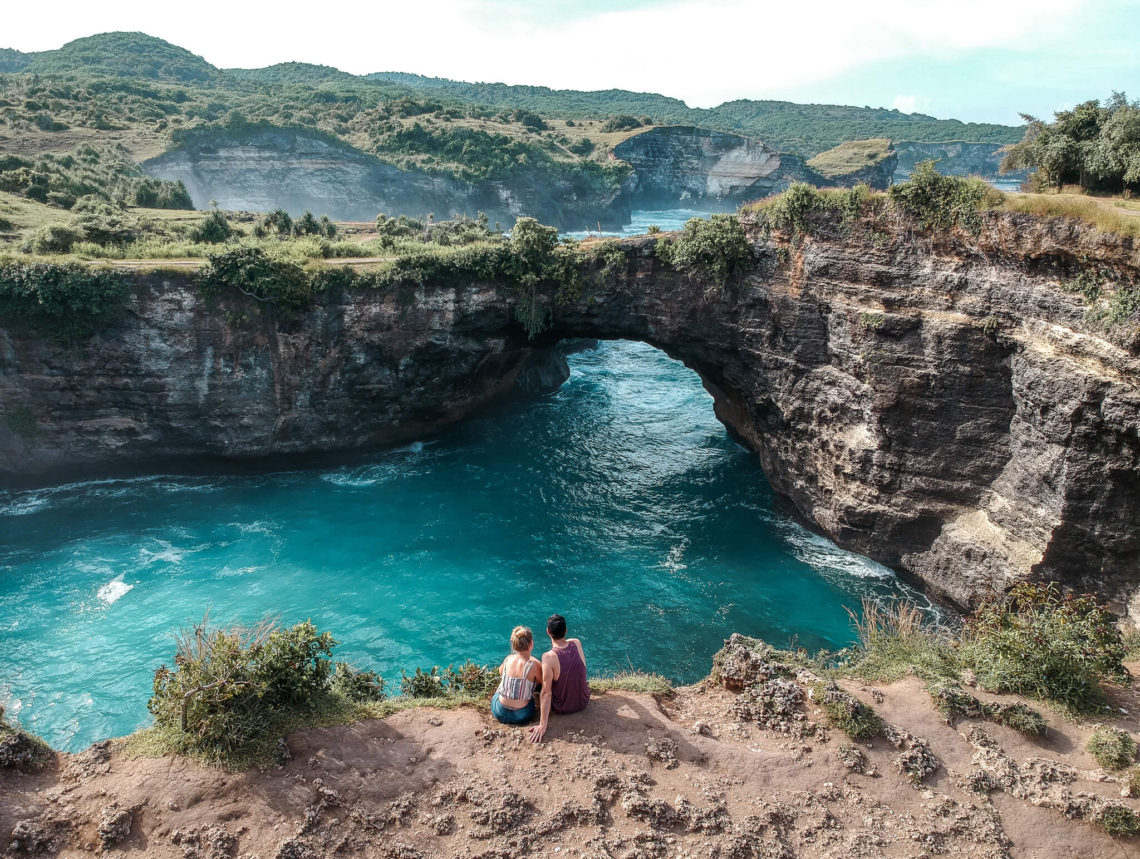
Communicating in Bali
If you are living in Bali, you will possibly want to purchase a sim card for your phone. Many places do have wifi, although the strength can sometimes be temperamental. Having your own mobile data is also handy if you are planning to order GoJeks or Grabs whilst out and about.
Sim cards in Bali are pretty cheap, costing as little as £5 for one month and a small amount of data. You can buy a SIM card from any of the food shops and even at stalls by the side of the road. Stalls on the roadside will be more likely to barter with you so we would recommend finding one of these.
We paid around £11 for 25GB of data and unlimited calls and texts. We have been with XL Axiata and have had no issues with the signal. Originally the price was about £20, however we bartered the price down to £11 and both parties left happy. This is just an example of the actual price that you should be paying for sim cards.
There are also many Facebook groups available to communicate with like-minded travellers in Bali. These are excellent ways to get involved with local activities and make new friends during your stay. SOme examples of these groups are:
Also Read – Sekumpul Waterfall – Your Ultimate Guide to Bali’s Biggest Waterfall
The Best Trips from Bali
The most wonderful thing about Bali is how quickly you can go from deep jungles and waterfalls, to crashing waves and epic surf. Bali is surrounded by other Indonesian islands, meaning it’s is easy to escape the mainland for a short trip.
There are 3 Nusa islands around a 45 minute ferry trip from Bali. These islands are part of Bali and are also predominantly Hindu culture. There are also larger islands, further away like Java and Lombok which are also easily reachable.
The Nusa Islands
Nusa Penida
This island is where the famous Instagram photo of the t-Rex is found, as well as the natural infinite pool of Angels Billabong. The largest Nusa island and the most popular among tourists. This island has some extremely bumpy roads so unless you are very confident on a scooter, it may be safer to hire a driver on this trip.
You can get a full day tour of Nusa Penida, leaving from mainland Bali and lasting about 5 hours on the island if you only want one day on the island. If you are planning on staying on the island, an 8 hour day tour with a private driver will cost around £40 for the car, water and a private tour guide/ photographer.
Between beaches, waterfalls and tree house views, you won’t be bored on Nusa Penida. There are so many beautiful sights to see that you will want to come back for more.
Grab and GoJek are not available here, so you will need to pay for the more expensive taxis if you do not plan on using a scooter.
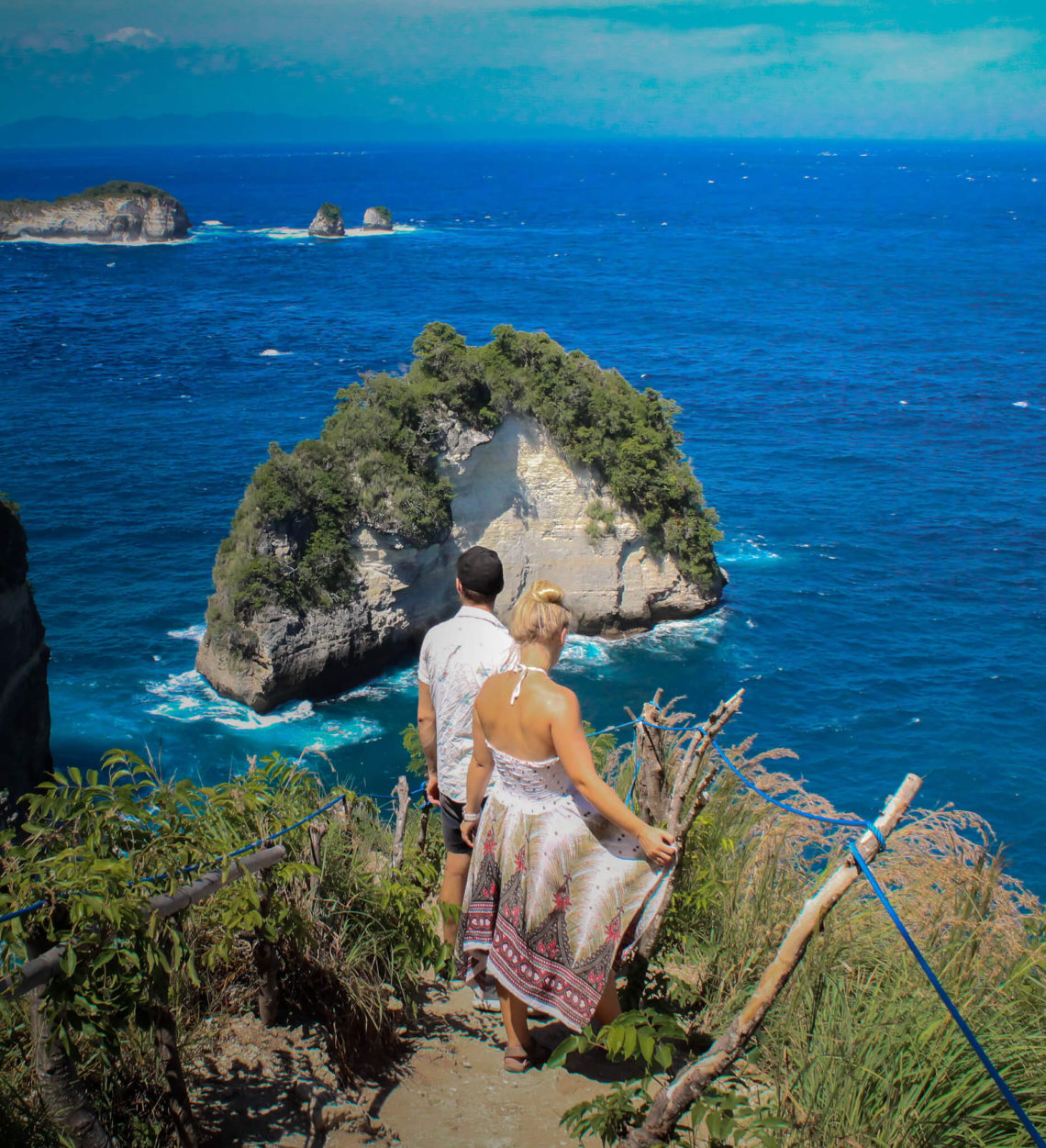
Nusa Lembongan
This island is well-known for the yellow bridge that links the island with Nusa Cenningan. The beautiful white sandy beaches are not to be missed and neither is the sunset. The roads are a lot better for riding a scooter on than Nusa Penida and it is also reasonably cheap to get a taxi, or in some cases this is jumping in the back of a truck!
Once again, Grab and GoJek are not available here, so you will need to pay for the more expensive taxis if you do not plan on using a scooter.
Nusa Ceningan
This small island is located between Penida and Lembongan and is becoming more popular among tourists. This is due to it being so easily accessible from Lembongan via the yellow bridge. This can once again easily explored by scooter.
Lombok Island
Lombok is another independent Indonesian island. It is smaller than Bali and a lot less touristy. If you are looking for a more remote escape with a lot less tourists around the island. With a different culture to Bali, visiting Lombok is a completely different experience to Bali.
Across the island you have a huge range of activities, from chasing waterfalls to surfing beaches. Unfortunately, in 2018 the island was hit with a disastrous earthquake, leaving communities across the island and the tourism in pieces. Although work is being done to rebuild the island, locals still struggle to afford life due to the tourists visiting the island.
If you visit Bali, I would strongly suggest taking a trip across to this beautiful place to help the people of Lombok rebuild and thrive once again.
The Gili Islands
There are three Gili Islands beside Lombok. Gili Trawangan is commonly known as the party island, Gili Meno the honeymoon island and Gili Air the retiree island. Of course these islands aren’t exclusive to these labels and each island is individually beautiful and worth a visit.
Here in the Gili Islands you can experience jaw dropping sunsets, fascinating under marvels and incredible live music. They are a popular trip to make from Bali and Lombok and it is easy to see why.
For a complete guide to the Gili Islands, including how to get there and where to stay, click here.
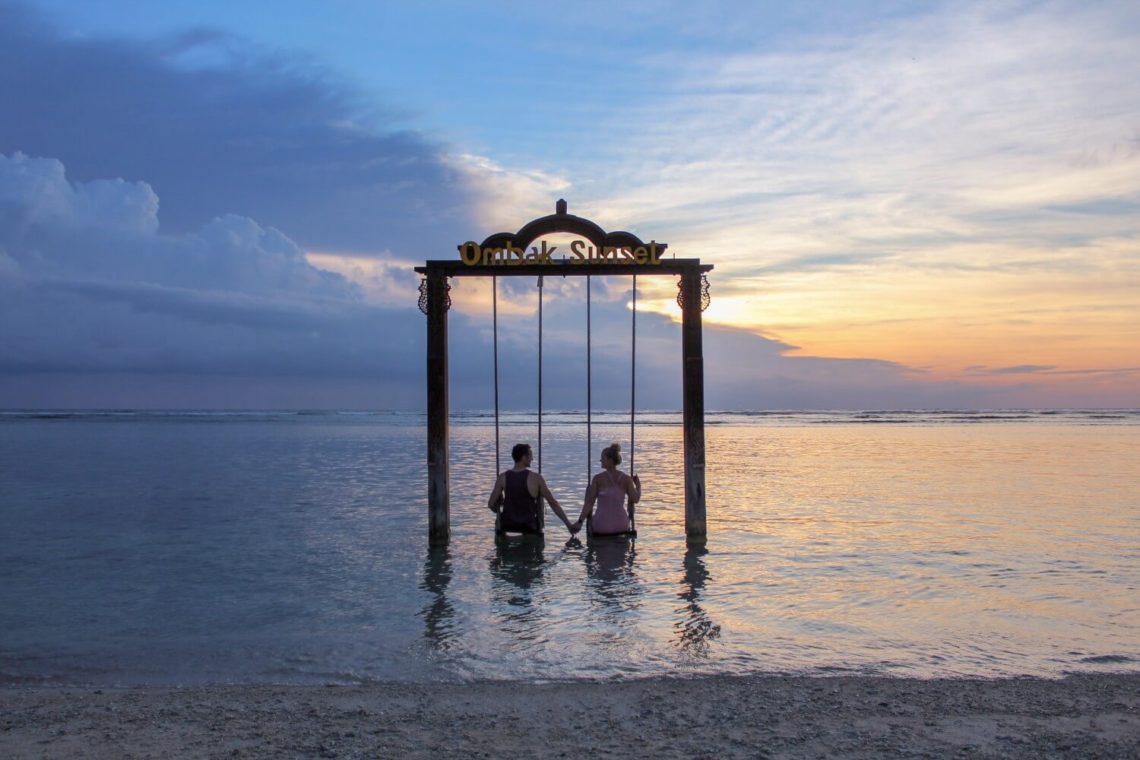
Java
Java is another independent island on the western side of Bali and is easily accessible via air or boat. This island is full of gems and it also has some active volcanos that you can arrange to hike up. Home to the capital city of Indonesia, Java is a much more developed island than Bali or Lombok.
Due to the sheer size of the island, the public transport around Java is much better than Bali and it is a popular choice of trip for solo backpackers. East Java is the most popular place to explore from Bali due to its close proximity and how undiscovered it remains.
Flores
One of the less visited islands near Bali is Flores, another beautiful place to go to in Indonesia. There are plenty of diving opportunities to swim with the sharks, turtles and manta rays or you can spend your time exploring the National Parks on land. Komodo Island is one of the most popular places to visit in Flores which is known for the fearsome komodo dragons that live there.
Living in Bali – Pros and Cons
Beside Bali being the ultimate paradise to live on, there are obviously some downsides to the island. These can range from the unbearable heat to the lack of variety in cheap food. All in all, the cons for living in Bali can mostly be attributed to the lack of home comforts anyone from the West may be used to. Of course, this can also be categorised as a Pro, depending on how adventurous you are and what you are looking for.
In the end, the only real way to know if you Bali is for you is to go and experience it for yourself. After one month on this incredible island you will either know whether you never want to leave or never want to come back.
Pros of Living in Bali
- The cost of living is very cheap
- You will be surrounded by likeminded individuals
- If you are feeling homesick, it is easy to find home comforts
- The food is delicious
- Adventure is right on your doorstep
Cons of Living in Bali
- It is difficult to obtain full residency status, meaning you are always on the move
- The temperature can get quite overwhelming
- If you choose budget living, home comforts can be hard to find
Extra Information
Helpful Locals
The Balinese are the nicest of people and will do anything to help you out, especially if it is scooter-related! They will happily do this as a good gesture and not be expecting any form of payment. If you ever need help with anything, do not be afraid to ask a local for assistance, even when there is a language barrier. They will most likely go out of their way to help you out.
Religion
Bali is a very religious island, as is Indonesia as a whole. Bali is the only country in Indonesia that has a majority following the Hindu religion. Due to this, you can walk down any street in Bali and be blessed with the smells of incense and the sights of the small woven square baskets made from coconut leaves and filled with flowers along with a gift for the God. These are called Canang and are offered by the woman.
There are also Balinese Muslims living in areas of Bali so there are many Mosques situated on the island. Throughout the day there will be call to Prayer, which is through a megaphone. It is good to have this in mind when looking for accommodation.
Laundry
There are many laundry’s around to freshen up your clothes. After driving about on a scooter all day your clothes can get pretty dirty! These laundries even offer a door service, where they collect your laundry, wash it for you and drop it back at your hotel.
Getting Around
Sights and attractions on Bali may look really close on a map, however it can actually take a really long time to get around the island. The traffic on this island is crazy and the roads were not built to handle the congestion. It can sometimes take you up to an hour to travel 10km, depending on how back the traffic is. If you want to get around in a hurry, or in a stress-free manner, the best time to commute is before sunrise.
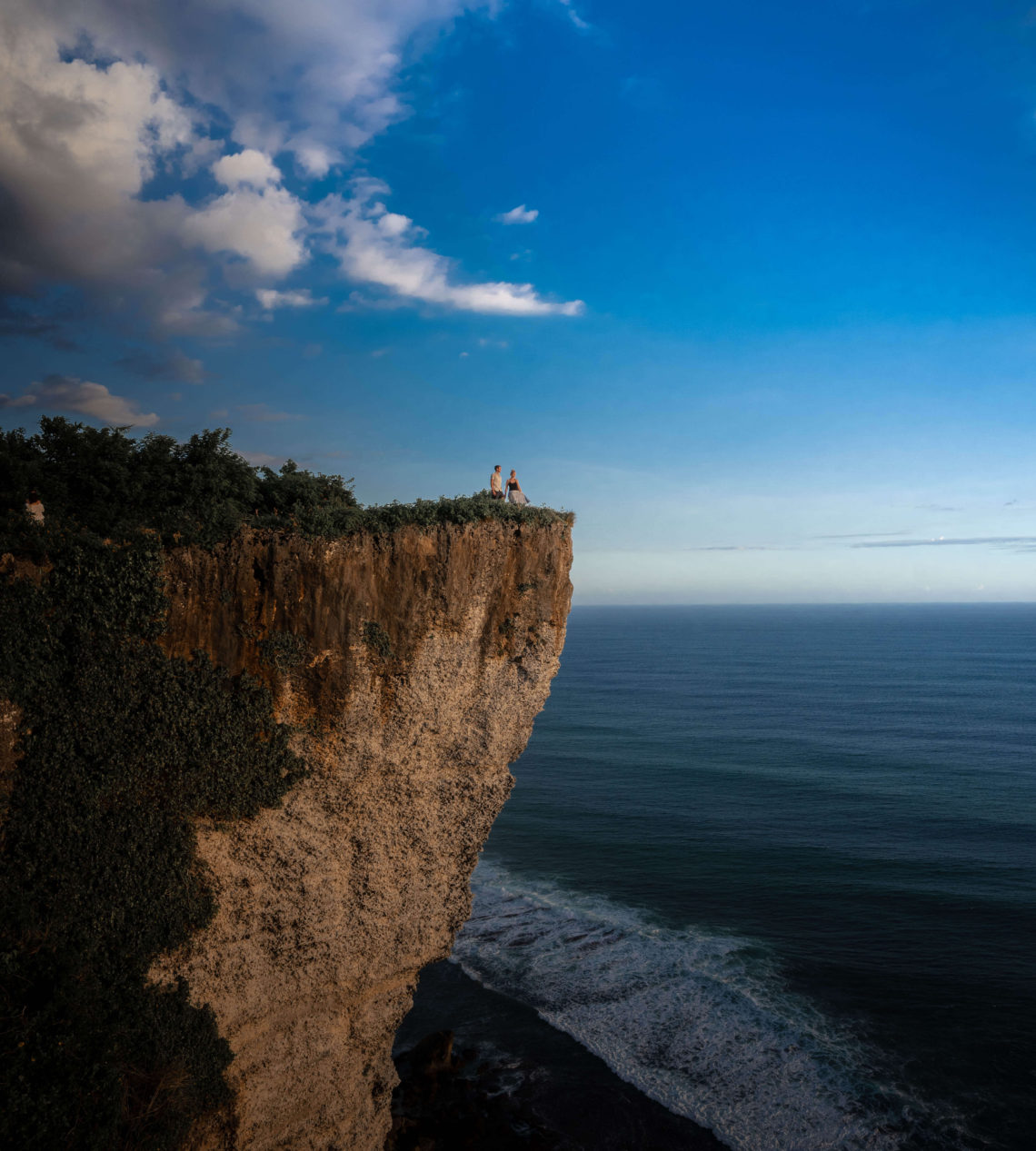
FAQs About Living in Bali
Can I live in Bali permanently?
There are a number of visa options for internationals seeking permanent residence in Bali. Majority of these are short-term, sponsored or purchased visas that last from 30 days to 5 years.
Read more about the visa options available for internationals over here.
Is it expensive to live in Bali?
Bali (as with the rest of Indonesia) offers a very affordable lifestyle compared to that of western countries. Depending on what level of comfort and lifestyle you choose, you can expect to pay from $300USD to $1500USD per month. This will cover all necessities, such as accommodation, food, drink, and activities, as well as other comforts.
Read the complete Cost of Living in Bali, Indonesia section for a full breakdown of costs.
How long can you stay in Bali without a visa?
For many countries around the world, there is a visa option known as the Visa on Arrival, which allows you to stay in Indonesia for 30 days. If you wish to stay for longer than this 30-day period, you are required to apply for either a visa extension or receive a different visa with a different method.
So there you have it, the ultimate guide to living in Bali, will all the information you will need to know for one month in Bali. If you have been to Bali recently, let us know how you found it in the comments below. What were your favourite sights? What did you think of the culture? Where was your favourite area? Let us know in the comments below.
If you are planning a full trip to Bali, make sure you check out the rest of our guides and Indonesia content to ensure a stress-free adventure. We will gladly answer any questions you have with regards to your trip, so either DM us or send us an email.
Don’t forget that sharing is caring! Be sure to share this article with your family and friends to let them know all about your new home. Maybe even inspire them to move to Bali themselves! Catch up with us on social media and see what we are currently up to. Tag us in your photos from your Bali adventure on Instagram so that we can share them with the rest of our community.
Read Now:
- The Ultimate Bali Itinerary – Seven Days in Bali Paradise
- Best Bank for Travelers – Starling vs Monzo Card Review
- The Definitive Guide to the Gili Islands, Bali; Gili Trawangan, Meno and Air
This article may contain affiliate links that provide us with a small income. For more information read our Affiliate page.
Pin it for later!
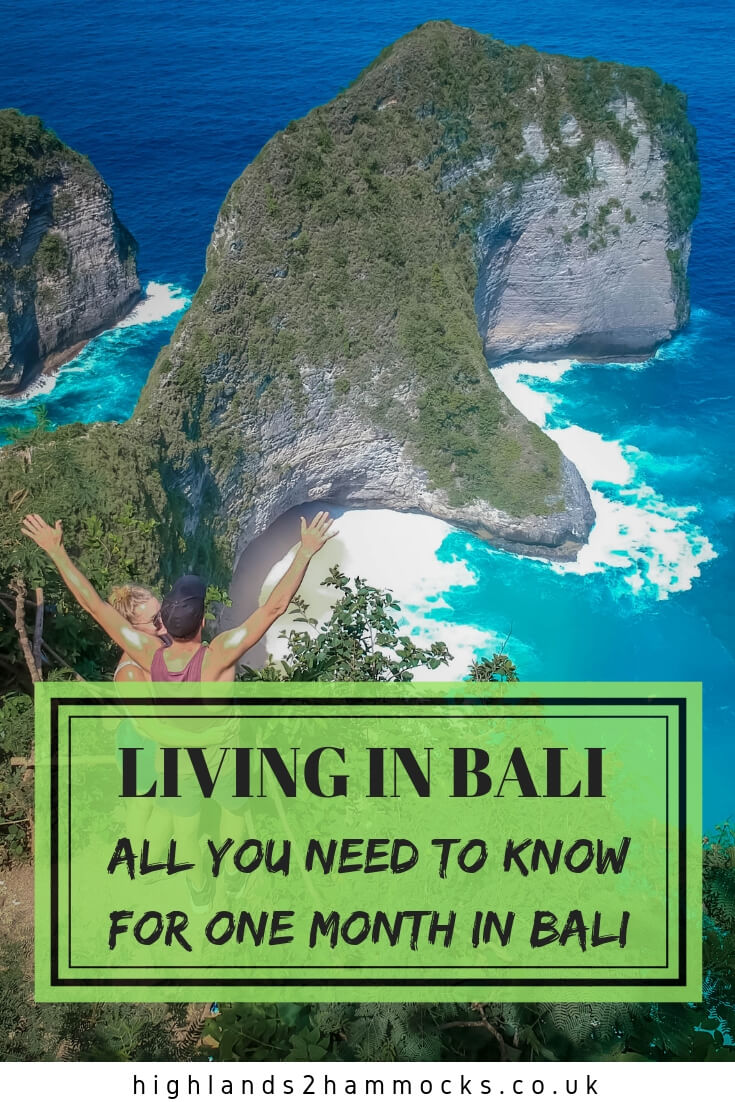



So helpful and answered all of my questions about Bali living costs – thank you so much!
I am so glad you found this guide useful! If you have any questions about any other part of visiting Bali just let us know and we can answer them for you. Enjoy your trip!
Pingback: The Ultimate Uluwatu Itinerary - Day Trip to Uluwatu Guide | highlands2hammocks
Pingback: Wanagiri Hidden Hills, Bali - WHAT, WHERE AND WHY.. | highlands2hammocks
Pingback: Bali Itinerary 10 Days - A Full Trip Guide - Divert Living
Pingback: 10 Days In Bali - The Ultimate Bali itinerary | The Wandering Vegetable
Pingback: The 8 Best Ubud Waterfalls - All You Need to Know | highlands2hammocks